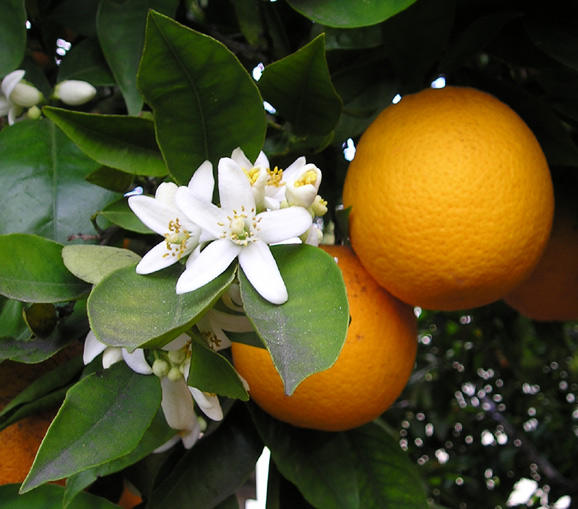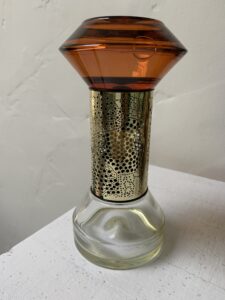Greetings dear Fragrance Friends,
If you are one of those rare individuals who’s ever taken a gummy, isn’t it weird how these random thoughts enter your mind that seem like epiphanies? That’s what happened to me last night when I decided to step it up from melatonin and for some reason started thinking about orange blossom perfume.
I can’t say I fell asleep immediately but I did have sweet dreams when I eventually did.
It’s been quite a while since I’ve given much attention to a particular scent type/note. Putting on my Nancy Drew hat and doing a dig into fragrance notes that I gravitate towards has always been something I’ve enjoyed. My first foray was with Best Gardenia Perfumes – My Top 6. I’ve always been intrigued by the history, social and often religious significance unique to a floral/ perfume note.
Growing up in CA the scent of orange blossoms was always one of my favorite aromas. It brings to mind happy and care-free childhood moments of fun in the sun.
Orange blossoms of the bitter orange tree is one of the most popular notes in perfumery. It’s innocent, delicate scent is pleasurable and life affirming. Orange blossom is a perfume note that has been widely used throughout history, regardless of shifts in olfactory fashion.
The orange tree is a godsend to the perfume industry. Its blossoms have found many uses in perfumery as well as cuisine, and it can be found in many forms – floral water, essential oil and an absolute. The precious raw materials found in the delicate white blooms are the sources of both orange blossom and neroli essential oils. They add an extraordinary fresh and floral touch to both classical perfume compositions as well as niche creations.
Orange blossom absolute is a natural fixative which is a valuable quality in perfumery. The compound allows the original composition to last longer, and at the same time, maintain its true fragrance.
Extracts from the bitter orange tree are very expensive, which is partly why they are often used in small amounts. Neroli is almost always diluted due to its exorbitant cost. Fortunately a little goes a long way with neroli and it also blends extremely well with other fragrance notes.
Almost all parts of bitter orange are used to produce gorgeous and aromatic materials for the fragrance industry. The fruit, known as sour orange is far too sour to eat and is studded with seeds, but its distinct bitterness makes it extremely fragrant. The essential oil comes from the peel of the fruit, orange leaves are used to produce petitgrain oil and its fragile white flowers are used to make orange blossom and neroli absolute.
The bitter orange tree has a well-deserved reputation as the gift that keeps on giving.
While orange blossom and neroli both contain unique olfactory features, the main difference between them lies in the method of extraction. Orange blossom absolute is obtained by solvent extraction using alcohol washing and filtering while neroli is derived by the steam distillation of freshly hand-picked flowers.
Orange blossom’s fragrance is sweet and intoxicating, whereas neroli’s scent is uplifting, fresh and green. Unlike orange blossom, neroli also contains a top note which is pleasingly bitter, fresh, sweet and herbal. Both conjure up images of femininity, innocence and pleasant summer afternoons.
ORIGINS
Originally from China and India, bitter orange trees were introduced to the Mediterranean region in the ninth century. From Spain to Sicily and from North Africa to Provence, orange blossom has been revered for centuries for its medicinal properties as well as its appealing aroma.
Bitter orange started to be grown as a perfume crop in the Grasse region in the 19th century. Unfortunately a persistent frost in the winter of 1956 destroyed many of the orange groves and sent the French sector into a massive decline. Production of the bitter orange crops were subsequently moved to North Africa. Although between 5 to 6 metric tons are still harvested in Vallauris, in southeastern France, it is a dramatic drop from the high of 2,000 metric tons in 1920.
Today, the perfume industry sources the bulk of its orange blossoms from three countries: Tunisia (the world’s leading producer), Morocco and Egypt.
The daidai, an Asian variety of bitter orange, is also used to produce essential oil in China. Although it is of a lower olfactory quality, it continues to be used in perfumery.
HISTORICAL SYMBOLISM AND USES
Throughout history, orange blossom has been associated with both purity and womanhood. Even in ancient Greek mythology, Zeus presented Hera with orange blossom on their wedding day. In much of the Mediterranean region, orange blossom has held a special association with weddings. Even today, it remains a symbolically important protector of couples and families.
During the Napoleonic era, the wealthiest brides wore real orange blossoms hand-picked that morning from their gardens. Others less fortunate had to resort to imported ones at great cost or settle for artificial ones.
Tradition held that the crown of the orange blossom honored the virtue of the bride who wore it and brought good fortune to the couple. If an unmarried woman were to be so brazen as to wear orange blossom it was assumed that she’d never find a suitable husband.
After gracing the bride’s brow on her wedding day, orange blossoms continued with her on her way to mature womanhood, initially soothing her during pregnancy and finally perfuming her first steps in motherhood.
Long known as a sleeping aid, it eventually found its way into the bridal bedroom in the form of sleeping drops. Often a bowl of water adorned with orange blossom would be placed alongside the bed to ensure the couple a restful night’s sleep.
Chinese traditional medicine has for years used an extract of the immature fruit (Zhi shi) to treat various digestive issues. In the West, orange blossom essential oil was used as a mild sedative but that practice has declined. Today it is mainly used in food processing and perfumery.
Orange blossom was seen in abundance at the French Court, as a floral water, an essence and even as dried flowers. It was also said to be a favorite of the Sun King, who apparently was allergic to all other perfumes. It remained popular with his successors, especially Louis XV and Marie Antoinette.
The royal orangeries at Versailles and Fontainbleau made their own floral water which was used to scent gloves and other articles of clothing.
Orange blossom has throughout history come to symbolize everything from pure, virginal girlhood to mature, sensuous womanhood, reflecting the female experience itself.
ORANGE BLOSSOM IN PERFUMERY
Sometimes called the “queen of eau de cologne” or “star of sensuous orientals”, orange blossom pairs as well with other white flowers and musks as it does with gourmand notes.
Whether you gravitate towards citrus, fresh, clean, bouquet, oriental or gourmand, chances are you will be able to find an orange blossom perfume to suit your preference.
Here are some noteworthy ones in each category:
Citrus: Muelhens Original eau de Cologne 4711 (it’s been around since 1792 for a reason), Tom Ford Neroli Portofino, Yves Rocher Matin Blanc
Fresh: Diptyque Eau des Sens, Bottega Veneta Parco Palladiano VII
Clean: Santa Maria Novella Zagara, Le Labo Fleur d’Oranger, Prada Infusion de Fleur d’Oranger
Bouquet: Giorgio Beverly Hills Giorgio (an intense bombshell that I still can’t believe I loved in the 80’s), Dior Pure Poison, Giorgio Armani Armani Code for Women
Oriental: Jean Paul Gaultier Classique, Guerlain Shalimar Souffle d’Oranger, Francis Kurkdjian APOM Maison
Gourmand: By Killian Love Don’t Be Shy, Yves St. Laurent Libre
My personal favorite orange blossom perfume when I need my orange blossom or neroli fix is Van Cleef & Arpels California Reverie (a little pricy but worth it), followed by Jo Malone London Orange Blossom (straight up orange blossom). I also adore The 7 Virtues Jasmine Neroli – I have the rollerball – but I would call it more jasmine than neroli. It layers really well with Jo Malone Orange Blossom which, though lovely, tends to disappear more quickly than I’d like.
My Diptyque Fleur d’Oranger hourglass diffuser which I splurged on while still living in New York is another serotonin booster. It’s a gorgeous aroma containing bark, leaves and citrus fruit. At just under $200 I almost didn’t buy it but absolutely zero regrets. The scent is amazing and the container is gorgeous. Tip: to make the oil last longer, don’t flip it over too often.
What about you? Does the scent of orange blossom perfume bring you to your happy place? We all need some cheer and self-care during these still crazy times. Please chime in with your thoughts!
Until the next time,
- Some of the Information stated here comes from NEZ magazine (Orange Blossoms in Perfumery edition)



I didn’t realize orange blossom can be very good for health. Sweet and pleasurable dreams are certain to put us in a good mood the next morning. I also enjoyed reading about its symbolism over the years. It does seem like orange blossom is associated with love and the feminine.
Hi Clark,
This little flower holds the power of showing its many faces in whatever perfume contains it. Depending on what it’s married with it can smell quite different and not all orange blossom perfumes smell distinctly feminine.
Thanks for popping in!
Erica
This is some really amazing information regarding orange blossom perfume. I had no idea that both orange blossom and neroli came from the same plant, although it does not surprise me. I also love how you included the origins of use and the historical symbolism in this article as well. Interesting stuff for people like me who love to know more about the fragrances they use.
Rachel,
This is just the tip of the iceberg. Orange blossom also appears frequently in art and literature but I didn’t want to go too far down the rabbit hole.
Thanks for reading and glad you found it interesting.
Erica
I love that your content is intricate, profound, and layered. I think there is a simple elegance that keeps everything afloat. I didn’t realize that orange blossom and neroli are used so often in perfume or that most of it comes Tunisia. I’d assumed it was grown here in the US.
There has been a fair amount written about orange blossom and its significance over the years. Maybe not as much as rose or jasmine, but if you do a little digging you can learn more.
Thanks for stopping by.
Erica